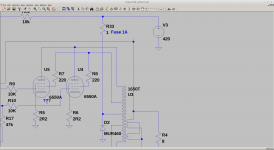Digikey has lots of 500 - 1000V DC rated fuses, both MIDGET and 3AG style. They even have slo-blo types in 5mm x 20mm size. They also carry panel mount fuseholders rated to 600V.
A regular diode to ground would conduct at all times. What are you saying???If you do put a fuse on B+ make sure its one of the longer ones, and put a catch diode to ground on the transformer side of the fuse. The primary inductance is enough to cause several KV across the fuse if it blows which will cause it to arc. The catch diode will conduct the primary current away until it reaches zero.
I think it can save other components including the output transformer in certain situations. Try and use an enclosed holder if possible.
Those round blue things rated 375 vac etc are called mos supressors. I've seen 600 v rated ones in factory variable speed drives, would be just the thing for saving a tube transformer after B+ fuse blue.
There are also TVS with high voltage ratings.
The organ Hammond put the B+ fuses in (in Canada only, CSA requirement) used a pentode, 7591. The fuse was in the transformer rectifier filter chassis, the pentodes were in a separate amp chassis. So the screen grid branch off from the plate was downstream of the fuse.
Last edited:
You do NOT repeat NOT fuse the speaker out on a Tube amp.
As of fusing +V supply, do so but it must also cut *all* otrer loads, including screens.
As of fusing +V supply, do so but it must also cut *all* otrer loads, including screens.
A better alternative is to connect the cathodes to ground with a small ( 1w) metal film
"flameproof" resistor of 10 ohms. If a tubes flashes the resistor will evaporate faster
then a fuse protecting the output transformer.
Tried that idea in the last century and it doesn't work as film resistors cannot take high slew impulse currents present in output stages (esp any idea of current transient square wave). Result one will be looking for unwanted distortion and lower power due to resistance(s) going high.
rJ
A regular diode to ground would conduct at all times. What are you saying???
Diode goes other way round like you would on a relay coil. If fuse blows current will still try to flow into transformer causing voltage to go negative by many KV. This will arc across the fuse. The diode stops the voltage going below 0V so the fuse needs to only handle HT.
As you said triode and UL only.
I like that solution as it results in the output stage not having HT on it in a failure.

Last edited:
It is a tube amp. I hadn’t really understood what I was protecting the speakers from, and it must have been a solid state amp which had had fuses, that I had seen.Can you clarify if you have solid state amps, or valve amps?
The remainder of my fusing philosophy is based on the page from Valve Wizard, which covers the issues discussed here, regarding fixed bias, for example.
Fuses and Fusing
Thanks everyone for improving my understanding of this!